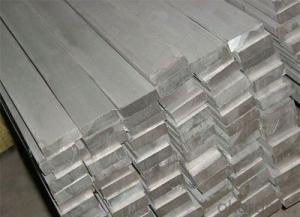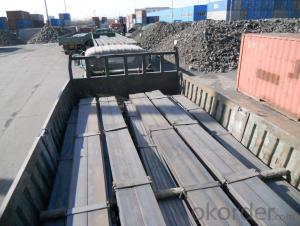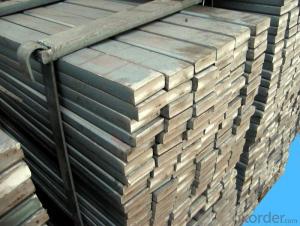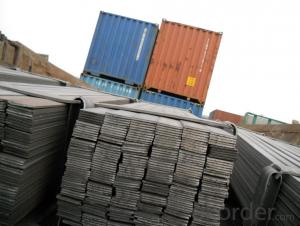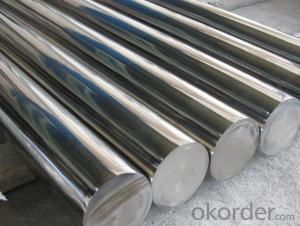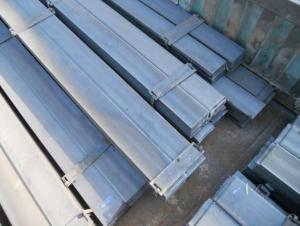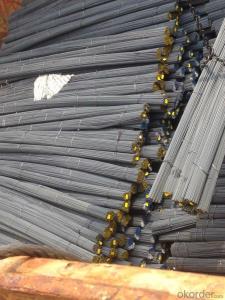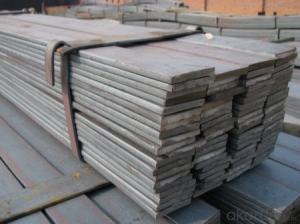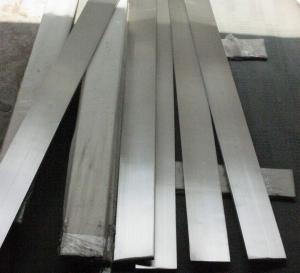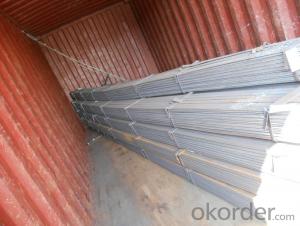Steel Flat Bar with High Quality for Construction
- Loading Port:
- China main port
- Payment Terms:
- TT or LC
- Min Order Qty:
- 25 m.t.
- Supply Capability:
- 10000 m.t./month
OKorder Service Pledge
OKorder Financial Service
You Might Also Like
Specification of Steel Flat Bar with High Quality for Construction:
Commodity: Hot Rolled Steel Flat Bar
Standard: GB;JIS
Material: Q195-Q235
Brand name: FLATSPACE
Origin place: China
Thickness: 3mm-30mm
Width:20mm-200mm
Length: Max 12m
Certification: SGS/BV
Usage/Applications of Steel Flat Bar with High Quality for Construction:
Widely used for construction, Machinery manufacturing, Iron tower steel structure, Shipbuilding; Steel grating, Staircase, Bridge, Viaduct, Railway spare parts, Boilers making etc.
Production Flow of Steel Flat Bar with High Quality for Construction:
The steel flat bar is made through three processes:
1.Feeding the material: Feeding the row material (the steel plate) to Slitting Line.
2.Slitting:The steel plate would be slitted into expected width by lengthways cutter.
3. Leveled and cutting: The plat bar would be ground into level by the grinder and then cut into required length.
Packaging & Delivery of Steel Flat Bar with High Quality for Construction:
1.Packaging Details: The Steel Flat Bars are packed in bundles and loaded in 20 feet/40 feet container, or shipped by bulk cargo ,also we can do as customer's requirements.
2.Delivery Details:30~45 days upon the receipt of buyer payment by T.T. or L/C.
3. Marks:
Color marking: There will be color marking on both end of the bundle for the cargo delivered by bulk vessel. That makes it easily to distinguish at the destination port.
Tag mark: there will be tag mark tied up on the bundles. The information usually including supplier logo and name, product name, made in China, shipping marks and other information request by the customer.
If loading by container the marking is not needed, but we will prepare it as customer requests.
FAQ:
Q1: Why buy Materials & Equipment from OKorder.com?
A1: All products offered byOKorder.com are carefully selected from China's most reliable manufacturing enterprises. Through its ISO certifications, OKorder.com adheres to the highest standards and a commitment to supply chain safety and customer satisfaction.
Q2: How do we guarantee the quality of our products?
A2: We have established an advanced quality management system which conducts strict quality tests at every step, from raw materials to the final product. At the same time, we provide extensive follow-up service assurances as required.
Q3: How soon can we receive the product after purchase?
A3: Within three days of placing an order, we will begin production. The specific shipping date is dependent upon international and government factors, but is typically 7 to 10 workdays.
Images:
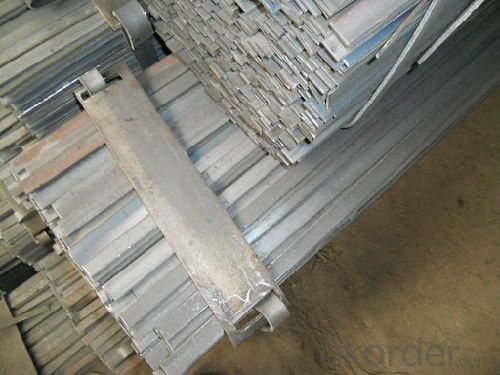
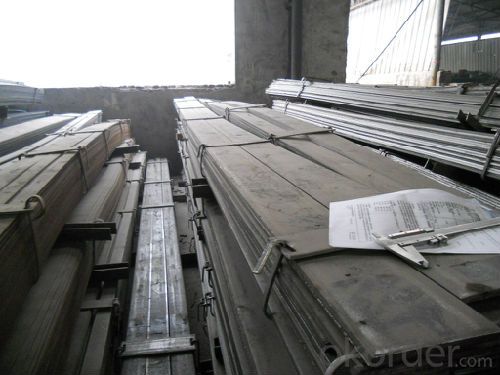
- Q: Can steel flat bars be used for manufacturing aerospace components?
- Yes, steel flat bars can be used for manufacturing aerospace components. Steel is a common material used in aerospace manufacturing due to its high strength and durability. Flat bars can be machined, formed, and welded to create various aerospace components such as brackets, supports, and structural elements. However, the specific grade and specifications of the steel should be carefully considered to meet the stringent requirements of the aerospace industry.
- Q: Are steel flat bars suitable for machining processes?
- Yes, steel flat bars are suitable for machining processes. They have excellent machinability due to their uniform shape and smooth surface, allowing for easy cutting, drilling, and shaping. Steel flat bars also offer good strength and durability, making them a popular choice for various machining applications.
- Q: Can steel flat bars be used for manufacturing automotive parts or components?
- Yes, steel flat bars can be used for manufacturing automotive parts or components. Steel flat bars are commonly used in the automotive industry for various applications such as brackets, supports, frames, and reinforcements. The high strength and durability of steel make it an ideal material for automotive manufacturing, as it can withstand the heavy loads and demands of the vehicles. Additionally, steel flat bars can be easily machined, welded, and formed into different shapes and sizes, allowing for customization and versatility in automotive component production.
- Q: How do you prevent twisting of steel flat bars during welding?
- To prevent twisting of steel flat bars during welding, there are several measures you can take: 1. Proper preparation: Ensure that the flat bars are clean and free of any contaminants, such as oil, grease, or rust. Use a wire brush or grinder to remove any surface impurities. 2. Proper clamping: Securely clamp the flat bars in place before welding. Use sturdy clamps or magnetic welding fixtures to hold the bars firmly in position, preventing any movement or twisting during the welding process. 3. Tack welding: Prior to performing the full weld, use tack welds to temporarily hold the flat bars together. This will help maintain their alignment and prevent twisting while the final weld is being applied. 4. Weld sequence: Adopt a strategic weld sequence that minimizes heat distortion and potential twisting. Avoid welding a continuous bead along the entire length of the flat bars, as this can generate excessive heat and cause distortion. Instead, alternate between different sections or weld in short intervals, allowing each area to cool before proceeding. 5. Minimize heat input: Control the heat input during welding by using the appropriate welding technique and adjusting the welding parameters. High heat levels can cause the steel to expand and contract, leading to twisting. Employing techniques such as pulse welding or reducing the amperage can help control heat input and minimize the risk of twisting. 6. Preheating and post-weld heat treatment: For thicker or more susceptible steel flat bars, preheating the material before welding can help reduce the risk of twisting. Additionally, performing post-weld heat treatment can relieve residual stresses and prevent distortion. 7. Slow cooling: Allow the welded flat bars to cool slowly and naturally after welding. Rapid cooling, such as through water quenching, can induce additional stresses and contribute to twisting. Avoid abrupt temperature changes and provide adequate time for the welded bars to cool down gradually. By implementing these preventive measures, you can significantly reduce the risk of twisting in steel flat bars during welding, ensuring a successful and distortion-free weld.
- Q: Can steel flat bars be used in architectural designs?
- Absolutely, architectural designs can certainly incorporate steel flat bars. These bars possess remarkable versatility, allowing them to enhance the aesthetics and functionality of various architectural projects. Their application ranges from structural elements like beams, columns, and braces to decorative purposes such as handrails, window frames, and furniture. Steel flat bars offer not only strength and durability but also a sleek and contemporary appearance that complements a vast array of architectural styles. By implementing appropriate design and fabrication techniques, these bars can seamlessly integrate into architectural designs, providing both visual appeal and structural reinforcement.
- Q: Galvanized flat steel how much is one meter?
- The price of galvanized flat steel is about 6200, so the price is 40 * 4 * 0.00785 * 1.06 * 6.2=8.3 yuan per meterGalvanized pipe price is about 6500, DN25:2.57 * 6.5=16.7 yuan / meter, DN32:3.32 * 6.5=21.58 yuan / meterAngle steel price 5000, 4# angle steel: 2.422 * 5=12.1 yuan / meter
- Q: What is the cost of steel flat bars?
- The cost of steel flat bars can vary depending on various factors such as the grade of steel, the size and thickness of the bars, and the quantity being purchased. Generally, the price range for steel flat bars can be anywhere from $10 to $50 per bar. However, it is important to note that these prices are just estimates and can vary significantly depending on the current market conditions and the specific suppliers. To get an accurate cost, it is recommended to contact local steel suppliers or check online marketplaces for the most up-to-date prices.
- Q: Are steel flat bars available in different alloys?
- Different alloys are available for steel flat bars. The most commonly used alloy for steel flat bars is carbon steel, which is widely used because of its strength and durability. However, there are other alloy options available, including stainless steel, alloy steel, and tool steel. Each alloy has unique properties and characteristics that make them suitable for various applications and industries. For instance, stainless steel flat bars are resistant to corrosion, making them ideal for use in environments with high moisture or chemical exposure. On the other hand, alloy steel flat bars offer increased strength and toughness, making them suitable for applications that require a high load-bearing capacity. Overall, the availability of different alloy options for steel flat bars allows customers to select the most suitable alloy based on their specific requirements.
- Q: -40x4 hot galvanized flat steel, a water 1m, what do you mean?
- This is an auxiliary grounding electrode lead, if the main body foundation has reached the design resistance of less than 4 ohms, can not be auxiliary grounding electrode.
- Q: What is the bending capacity of a steel flat bar?
- The bending capacity of a steel flat bar depends on various factors such as the dimensions of the bar, the type and grade of steel, and the specific application. To determine the bending capacity, engineers typically consider the yield strength, tensile strength, and modulus of elasticity of the steel. Additionally, the bar's width, thickness, and length will also affect its bending capacity. It is crucial to consult engineering reference materials or perform calculations to accurately determine the bending capacity of a specific steel flat bar.
Send your message to us
Steel Flat Bar with High Quality for Construction
- Loading Port:
- China main port
- Payment Terms:
- TT or LC
- Min Order Qty:
- 25 m.t.
- Supply Capability:
- 10000 m.t./month
OKorder Service Pledge
OKorder Financial Service
Similar products
Hot products
Hot Searches
Related keywords











